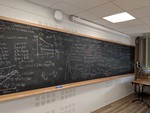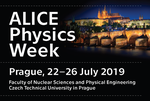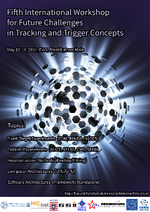2025
Phase Structure of Strongly Interacting Matter under Extreme Conditions
Lower-Order Fluctuations (Theory): Insights from Experiment to Theory Comparisons
Strongly Interacting Matter under Extreme Conditions
Probing the Nature's Primordial Fluid
Cumulants and fluctuations measurement at the BES II
The antiproton puzzle, QCD critical point, and fireball properties in heavy-ion collisions
High density QCD/Phase diagram
Factorial cumulants as a probe of fireball properties in heavy-ion collisions
Fluctuation Probes of QCD Matter in Heavy-Ion Collisions
2024
Fluctuations and correlations in heavy-ion collisions as a probe of the QCD phase structure
2023
Cooper-Frye sampling with short-range repulsion
Proton number cumulants in heavy-ion collisions and the search for the QCD critical point
Proton number cumulants and correlation functions at RHIC-BES from hydrodynamics
2022
Baryon annihilation and multiplicity dependence of p/$\pi$ and light nuclei ratios
QCD phase structure from fluctuations in heavy-ion collisions
Hadronic resonance production in a partial chemical equilibrium model
Proton number cumulants and correlation functions from hydrodynamics and the QCD phase diagram
We present a dynamical description of (anti)proton number cumulants and correlation functions in heavy-ion collisions by utilizing hydrodynamics simulations [1]. The cumulants are calculated via an appropriately extended Cooper-Frye …
Unveiling the Properties of Strongly Interacting Matter under Extreme Conditions
2021
Net-particle number fluctuations in a hydrodynamic description of heavy-ion collisions
2020
Probing the QCD equation of state with fluctuations of conserved charges
Pion condensation in the early Universe at nonvanishing lepton flavor asymmetry
Pion condensation in the early Universe at nonvanishing lepton flavor asymmetry
Recent results on light nuclei production in extended thermal model descriptions
Nuclear clusters in an off-equilibrium thermal model
2019
(Anti-)Nucleosynthesis in the Little and the Big Bang
Equation of state of QCD matter within the Hagedorn bag-like model
2018
QCD equation of state at finite baryon density with Cluster Expansion Model
Lattice-based QCD equation of state at finite baryon density: Cluster Expansion Model
Lattice QCD methods allow to calculate the thermodynamic observables at finite temperature and imaginary chemical potential. The Wuppertal-Budapest collaboration data [1,2] for the temperature dependence of the leading four Fourier …
2017
van der Waals Interactions in Hadron Resonance Gas: From Nuclear Matter to Lattice QCD
We construct an extension of the ideal hadron resonance gas (HRG) model which includes attractive and repulsive van der Waals (VDW) interactions between hadrons, and analyze different observables with this model [1]. The VDW parameters …
van der Waals Interactions and Hadron Resonance Gas: From Nuclear Matter to Lattice QCD
Extension of the ideal hadron resonance gas (HRG) model is constructed which includes attractive and repulsive van der Waals (VDW) interactions between hadrons [1]. The model employs a novel multi-component quantum statistical VDW …
2016
Analysis of hadron yield data within HRG model with multi-component eigenvolume corrections
The hadron-resonance gas (HRG) model with the hadron type dependent eigenvolume (EV) corrections is employed to fit the hadron yield data of the ALICE and the NA49 collaborations. The influence of the EV corrections is studied within …


































































































